Table of contents
What is the difference between DNA vs RNA? These molecules are the most important building blocks in living things as they help make life possible. DNA stands for deoxyribonucleic acid, and RNA stands for ribonucleic acid. DNA and RNA are both nucleic acids and carry genetic information, but they also have their differences.
Let’s go over these differences and similarities and discover why they are pivotal to life.
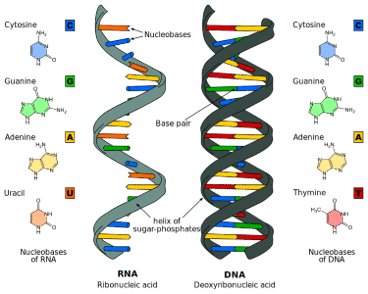
DNA vs RNA Difference Summary Table
| DNA (deoxyribonucleic acid) | RNA (ribonucleic acid) | |
|---|---|---|
| Function | Store and replicate genetic information—the blueprint for all genetic traits | A copy of DNA with instructions on cellular functions and protein synthesis |
| Structure | Double helix | RNA is a single stranded molecule but intermittently forms a double helix structure |
| Nucleotide composition | Each nucleotide contains a phosphate group, a 5-carbon sugar, and a nitrogenous base (adenine, guanine, cytosine, thymine) | Each nucleotide contains a phosphate group, a 5-carbon sugar, and a nitrogenous base (adenine, guanine, cytosine, uracil) |
| Type of sugar | Deoxyribose sugar is a monosaccharide containing three hydroxyl groups (-OH–) | Ribose sugar is a monosaccharide containing four hydroxyl groups |
| Base pairing | Cytosine – Guanine Adenine – Thymine | Cytosine – Guanine Adenine – Uracil |
| Length | In comparison, DNA is much longer than RNA. A single strand of DNA would be around 2 m long | RNA molecules vary in length, but they are much shorter than DNA |
| Location | DNA is located in the nucleus, with some DNA found in the mitochondria | RNA forms in the nucleolus and is found in the cell’s cytoplasm |
| Reactivity | DNA is highly stable, thanks to its strong C-H bonds and the fact that it contains one less hydroxyl group. This stability is useful for a molecule in charge of keeping genetic material intact | Due to its extra oxygen (in the hydroxyl group), RNA is more reactive than DNA. Therefore, it is especially not stable under alkaline conditions and is susceptible to enzyme attack. This is useful for a molecule that has to be produced, degraded, and recycled constantly |
What is the difference between DNA vs RNA?
Let us now explore in more detail how does RNA differ from DNA.
Function
DNA is like a flash drive or computer chip with all the information needed to carry out cellular processes and produce proteins. It has to pass on this information to all new cells being made so that the processes are carried on in the exact same manner. This blueprint is essential to the continuity of life.
RNA is like the decoder as it makes a copy of this drive and relays the instructions to the rest of the cell. This comprises a series of complex steps with different types of RNA delivering different processes. The three main types of RNA are:
- Messenger RNA (mRNA) makes a copy of the genetic code through the process of transcription. It transports this copy from the nucleus to the ribosomes, where it is translated into proteins.
- Transfer RNA (tRNA) is a complex molecule that contains an amino acid, which is brought into the ribosomes in response to each particular coded section of mRNA.
- Ribosomal RNA (rRNA) is a non-coding RNA that composes ribosomes, the site of protein synthesis.
Structure
The iconic double helix structure of DNA is well-known in popular culture. The structure of RNA, not so much. A double helix structure means that the two strands joined by the hydrogen bonds between the nitrogenous bases coil together in the pattern that we all know due to its structure and weight.
This does not happen with RNA since it is a single strand. However, RNA can form double-stranded structures, at least momentarily. For example, during the process of translation, there is a moment in which mRNA pairs with tRNA. This short double-strand will cause RNA to coil for that instant.
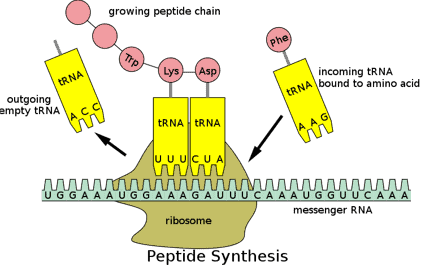
Nucleotide composition
Nucleotides are the monomers that make up the polymers DNA vs RNA. A nucleotide is made of three basic components:
- A monosaccharide-simple sugar that cannot be decomposed into a simpler sugar
- A phosphate group
- One of the four nitrogenous bases
The structural difference between nucleotides rests in two instances:
- A DNA nucleotide contains deoxyribose sugar, whereas an RNA contains the sugar ribose in every nucleotide.
- The nitrogenous bases in DNA can be adenine, guanine, cytosine, and thymine. Unlike DNA, RNA contains a uracil nitrogenous base instead of thymine.
Type of sugar
The backbones of both DNA and RNA are a sugar molecule and a phosphate group. Regarding the type of sugar, RNA contains the sugar ribose, whereas DNA contains deoxyribose. As the name indicates, “deoxy” means that while RNA has two hydroxyl groups (-OH) attached to the backbone, DNA contains only one hydroxyl group since there is no oxygen attached to hydrogen, where it would go in RNA.
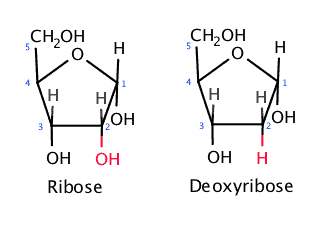
In other words, and as you can see in the figure above, deoxyribose sugar is one oxygen short from ribose.
Why is this difference important? The extra oxygen in RNA provides it with more flexibility, a helpful characteristic for a molecule that converts genetic code into proteins. On the other hand, deoxyribose sugar gives DNA more stability, which is necessary for the molecule that carries the blueprints that need to be passed on from one generation to the next.
Bases and base pairing
As we have mentioned before, each nucleotide is composed of a phosphate and a sugar backbone. All across DNA vs RNA, this backbone has the same structure – deoxyribose and phosphate or ribose and phosphate respectively. The part that makes each nucleotide unit different is its nitrogenous base.
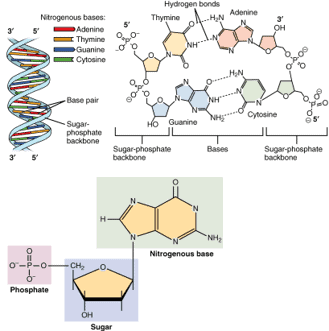
Nitrogenous bases are composed of carbon and nitrogen rings. The number of rings in a base determines if it is either a purine (two rings) or a pyrimidine (one ring). The illustration below shows the structures of purines and pyrimidines. The most apparent difference between the two groups is their size and structure.
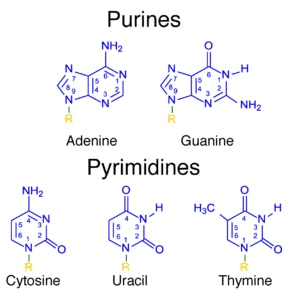
A purine will always bond with a pyrimidine through complementary base-pairing. This is convenient to allow proper spacing between successive nucleotides in a DNA or RNA strand.
DNA base pairs are A::T and G::C. Since RNA does not contain thymine, the base pairs are A::U and G::C.
One of the reasons why DNA uses thymine instead of uracil is that thymine has better resistance to photochemical mutation, another convenience to stability. Uracil is also more resistant to oxidation, a trait needed in an environment outside the nucleus where it will find oxygen. Thymine on the other hand, which is susceptible to oxygen, is stored safely inside the nucleus.
There are many publicly available videos on DNA vs RNA from services such as YouTube. You can view it wherever you are.
Length of DNA vs RNA
A DNA molecule making up a single chromosome is usually composed of around 200 million nucleotide pairs. This is equivalent to about 2 inches (5.08 cm) in length.
The RNA molecules produced from transcription detach from the parent DNA in the form of a short strand. Because they are copies of only a certain region of DNA, RNA molecules are much shorter than DNA. They are no more than a few nucleotides long.
Location of DNA vs RNA
DNA is conveniently stored inside the nucleus in the form of chromosomes. This also makes it easier to be transferred. In addition to the nucleus, you can find DNA in the cell’s power plants: the mitochondria.
There are three types of RNA, and they are found in different locations. The transcribed copy of DNA, mRNA, exits the nucleus into the cytoplasm, where it is directed by the cytoskeleton around the cell as needed. tRNA is also a molecule that roams around the cytoplasm. When signaled by the ribosome, it will find free amino acids and bring them in for protein synthesis. As mentioned earlier, rRNA is part of the ribosome, the organelle where protein synthesis takes place.
Reactivity of DNA vs RNA
DNA is a critical part of organisms, and as such, it needs to stay protected against changes such as attacks or mutations. Proteins protect DNA inside the nucleus. In addition, the molecule has several repair mechanisms and is stable in alkaline conditions.
On the other hand, RNA is more reactive than DNA. In addition, its single-strand structure makes it more vulnerable to enzyme attacks.
DNA is more vulnerable to damage by ultraviolet radiation than RNA. The link between UV radiation and skin cancer is caused in part by this vulnerability.
Similarities Between DNA vs RNA Molecules
To this point, you have probably noticed several similarities between DNA vs RNA. For starters, we can easily note that they are both types of nucleic acids, chainlike molecules composed of nearly identical units called nucleotides. Individual nucleotides are called monomers, while the linked together molecule is called a polymer.

Here’s a list of some other similarities between these molecules:
- They both contain four nitrogenous bases, three of which are found in both types of nucleic acid.
- The structure of the nucleotides is very similar. They are all made of a phosphate group, a sugar molecule, and a nitrogenous base.
- In both DNA and RNA, the monomers are bonded through phosphodiester bonds between the 3’ carbon end of one molecule and the 5’ carbon end of the next.
- In both cases, the backbone is made of a sugar-phosphate backbone.
Decode your DNA with Nebula Genomics
DNA and RNA are both fantastic molecules with specific characteristics that make them suitable for their job. The intricate design of DNA makes it unique, and it has been the topic of interest not only in research, but also forensics, paternity tests, and commercial genetic testing for traits and diseases.
At Nebula Genomics, we know the importance of knowing what is written in your DNA to your health and well-being. This is why we offer optimal services that decode 100% of your DNA to provide you with a complete picture of your genome.
Whether you want to know about your ancestry, your close family, or would like to check if you are susceptible to developing a certain disease, or maybe want to create a personalized diet, our 30x Whole Genome Sequencing guarantees complete information of your genome. So go ahead and order your DNA test kit today!
Looking for more educational material? You may be interested in our other articles such as this one on the history of the DNA model.
Edited by Christina Swords, PhD
